Author: Aylo
Compiled by: Tim, PANews
First of all, you cannot successfully escape the peak. You can't do it, I can't do it, and I wouldn't even try.
Cycle tops appear quickly in a short time, but they are usually not obvious and can only be confirmed after a long period.
Day traders who focus on short-term trends may seize opportunities, but they have already made too many judgments about the cycle top before this, and these misjudgments have long lost their meaning. Their gaze has never turned to a broader perspective.
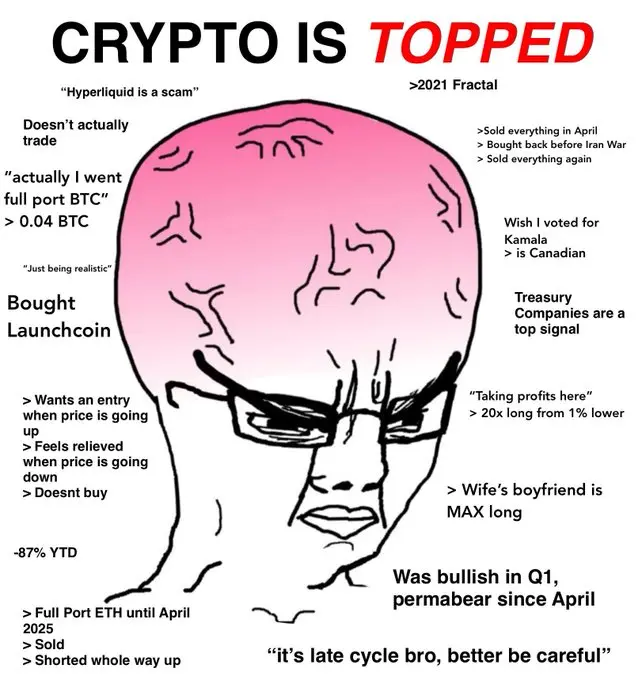
I am just a student learning market trading, still in the stage of continuously accumulating knowledge and experience. I have not yet experienced enough market cycles, so I do not dare to consider myself an expert; I am here to be honest.
Making independent decisions, I bear the profits and losses myself. I never consider myself a prophet; it is common for new things to emerge and overturn old views.
Evidence for the "Four-Year Cycle Theory"
Looking back at the historical price charts of BTC, there is a clear pattern: December 2013, December 2017, November 2021. This four-year cycle has maintained an astonishing regularity, and market patterns often continue until they are fundamentally disrupted.
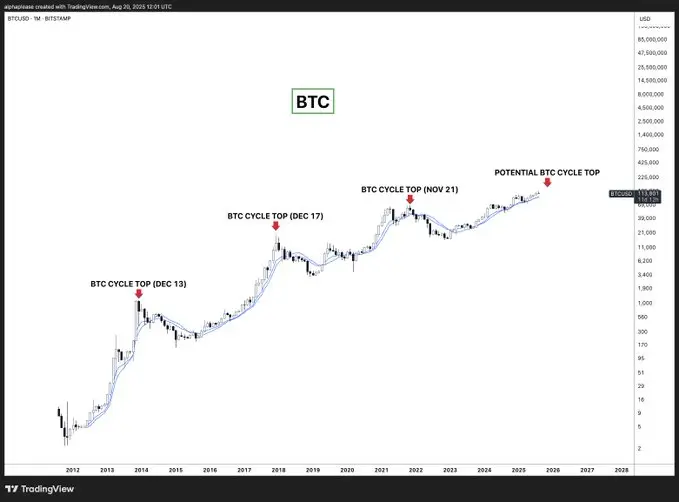
Reasons why the four-year cycle pattern may continue to hold:
- Psychological set: The four-year cycle in the crypto market is deeply ingrained.
- Self-fulfilling prophecy: The general market perception may trigger collective sell-offs, coupled with hidden leverage factors in the system (like the current digital asset treasury DAT?).
- Bitcoin halving correlation: The supply shortage caused by Bitcoin halving events typically creates price peaks 12-18 months in advance (although in the current cycle, this seems more narrative-driven).
- Occam's Razor principle: The simplest explanation is usually the correct one; since it has worked three times, why complicate it?
(Note: Occam's Razor principle states that among competing hypotheses, the one with the fewest assumptions should be selected. In other words, avoid unnecessary complexity.)
We are definitely not in the early stages of this cycle; Bitcoin has already risen significantly from the bottom. The four-year cycle pattern indicates that we are approaching the top of a bull market.
Refuting the Four-Year Cycle Theory (i.e., the 2026 Bull Market Theory)
I have a simple question: Will institution-driven cycles really look exactly the same as the previous two retail-driven cycles?
I generally agree with market cycle theory, so this discussion does not include super cycles, but I believe market cycles can be influenced by other factors, leading to underextension or overextension.
Why might this time really be different?
1. Differences in behavior patterns between institutions and retail investors
- The flow of funds from spot ETFs and traditional exchanges has created a new liquidity model.
- Institutions systematically take profits more smoothly than retail behavior, resulting in less panic.
2. Traditional indicators may have failed
- We have a lot of cycle analysis tools (like NVT, MVRV, etc.), but their historical applicability is mainly based on retail-dominated markets.
- Institutional participation has fundamentally changed the situation of "over-bubbling."
- When calculated in gold prices, Bitcoin's current price hasn't even exceeded the previous cycle's peak, so it cannot be considered a bubble.
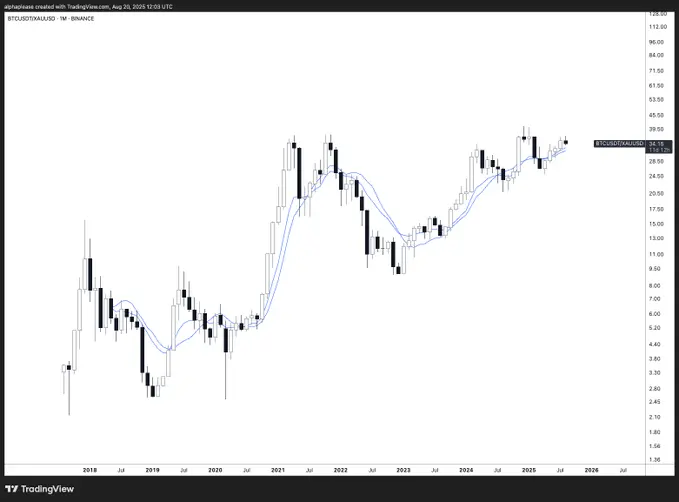
3. Changes in the regulatory environment
- The regulatory environment in this cycle is completely different; cryptocurrencies are now accepted by the U.S. and the SEC, and the institutional framework is gradually becoming clear.
- The end of previous bull market cycles was partly due to regulatory storms (like the 2018 crackdown on ICOs).
- The possibility of systemic sudden risks leading to the end of the cycle has been largely eliminated.
4. Federal Reserve and macro dynamics
- Federal Reserve Chairman Powell's term will end in May 2026, and Trump may announce his successor at the end of 2025.
- The "shadow Fed chair" effect not only weakens the current monetary policy's effectiveness but also creates preemptive buying due to market expectations that Trump will nominate a dovish chair.
- The first Federal Open Market Committee meeting of the new Fed chair will be held on June 17-18, 2026, which is a potential catalyst event.
- The extended "Goldilocks environment" runs through the economic transition period.
(Note: The Goldilocks environment is an economic term referring to the ideal state of "high growth + low inflation," derived from the metaphor of "not too hot, not too cold, just right" in the fairy tale "Goldilocks and the Three Bears.")
Historical patterns indicate that changes in the Federal Reserve chair usually attract market attention.
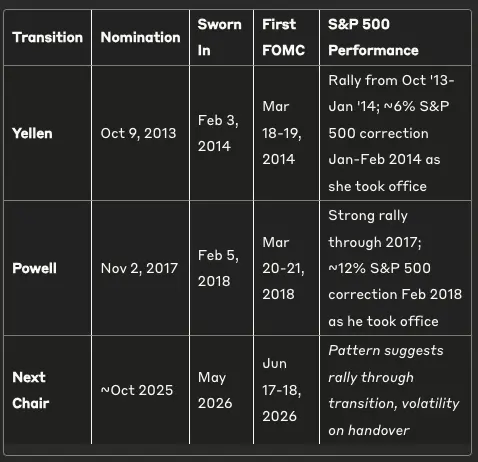
A consistent pattern: Both chair transitions have shown the same scenario: nomination news boosts the stock market, with the rally continuing throughout the transition period, but when the new chair officially takes office, the S&P 500 index always retreats.
During Yellen's transition (January-February 2014), the S&P 500 index fell about 6%; during Powell's transition (February 2018), it triggered about a 12% pullback. This suggests that the new chairperson announced by Trump at the end of 2025 may extend the bull market into the transition period, but the power transition phase in May-June 2026 is highly likely to see market turbulence, which may coincide with the cycle top.
5. Changes in market structure
- Concerns about currency devaluation are giving rise to new driving factors beyond "risk appetite."
- The market capitalization of stablecoins, as a leading indicator, is currently continuing to grow (our "reserve" indicator).
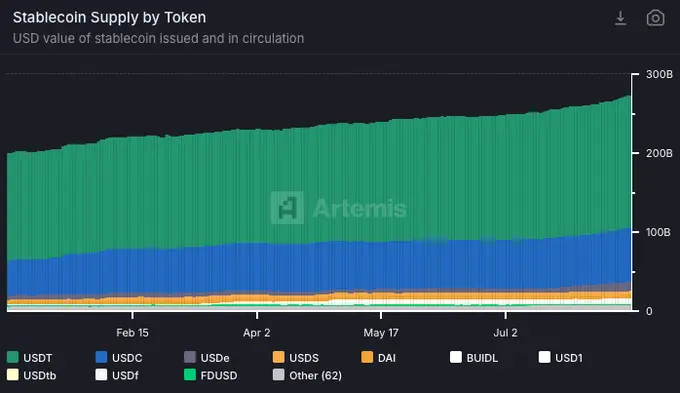
The sources of demand for Bitcoin are more diversified than in previous cycles: ETFs, digital asset treasuries, pension funds.
What factors could prematurely end the 2026 bull market theory and lead to the re-emergence of the four-year cycle?
- Leverage risks in digital asset treasuries: I observe that the strongest bearish factor is that digital asset treasury companies may liquidate leveraged positions at a faster-than-expected pace. Large-scale forced sell-offs could crush buying power and change market structure. However, it is necessary to distinguish between two situations: losing buying demand (when net asset valuation is still 1) and being forced to become sellers, triggering a "chain sell-off." If the main treasury buying power weakens, it will obviously have a significant impact on the market. There are already many signs indicating that this situation is occurring, whether it is Strategy or major ETH treasury institutions, net worth has seen a significant decline. I do not turn a blind eye to this, and neither should you, so it is essential to keep a close watch on this situation.
- Macro risks: A resurgence of inflation is the real macro risk, but I have not yet seen evidence of this. Cryptocurrencies are now highly correlated with the macro environment, and we are still in a Goldilocks economic environment.
Characteristics of the top that have not yet appeared
Euphoria has not arrived
Concerns persist: every 5% drop triggers voices claiming the market has peaked (this has lasted for 18 months).

There is no continuous euphoria in the market or a unified view on a sustained upward trend.
No top sell-off behavior has occurred (non-essential)
If the crypto market experiences a significant rise and outperforms the stock market by the end of this year, this explosive peak signal may indicate that the crypto market will peak before the business cycle peaks, while this business cycle is likely to extend until 2026.
Stablecoin leading indicators
A particularly useful indicator: the growth status of stablecoin market capitalization
In traditional finance, the growth of M2 money supply often precedes asset bubbles. In the crypto market, the total market capitalization of stablecoins plays a similar role, representing the total "dollar" liquidity available in the crypto market.
Historical data shows that major cycle tops in the crypto market often occur 3-6 months after the growth of stablecoin supply stagnates. As long as the supply of stablecoins continues to grow significantly, it indicates that the market still has ample room for upward movement.
My Current Viewpoint
With a gun to my head, I say that based on current observations, I do not see the arrival of a major cycle top before 2026 (this view can change quickly, so there's no need to be overly serious).
We only have three data points regarding the four-year cycle for verification, and institutional participation represents a fundamental change in market structure. Just the news of the Federal Reserve chair transition could extend the Goldilocks environment to 2026, which I believe is particularly important, especially given the current correlation between cryptocurrencies and the macro economy is far greater than before.
In this cycle, market participants have a deeper understanding of the four-year cycle theory, which makes me feel that the outcome will be different. When have people ever made the right judgment? Are they all ready to follow the four-year cycle rules and sell off together?

However, I admit that this four-year cycle law has been astonishingly stable, and market patterns often persist until they are broken. When the public begins to realize this cycle, it may precisely form a self-fulfilling prophecy that ends the pattern.
I will continue to take profits on altcoins that have risen too much when Bitcoin's dominance (BTC.D) falls, but I will firmly hold Bitcoin, predicting that it will reach an all-time high in 2026. Please be aware: regardless of how the current market cycle evolves, the altcoins you hold may peak at any time.
Conclusion
The four-year cycle law is the strongest argument supporting the theory of a peak in 2025; this pattern has been validated three times, and simple patterns often work. However, the changes in market structure brought by institutional investors, the uniqueness of the Federal Reserve's policy transition period, and the lack of euphoric signals in the market suggest that this cycle may extend until 2026.
The coming months are unpredictable, and it is unwise to seek certainty in uncertainty.
Regardless, recognize reality; once you realize you cannot escape the peak, you can start formulating a systematic exit strategy.
The right position is one that allows you to sleep soundly at night. Even if you sell too early, it doesn't matter as long as you have made enough profit.
I am absolutely open to all opinions, including dissenting ones. Writing this article is to help myself make decisions and to "learn publicly."
免责声明:本文章仅代表作者个人观点,不代表本平台的立场和观点。本文章仅供信息分享,不构成对任何人的任何投资建议。用户与作者之间的任何争议,与本平台无关。如网页中刊载的文章或图片涉及侵权,请提供相关的权利证明和身份证明发送邮件到support@aicoin.com,本平台相关工作人员将会进行核查。




